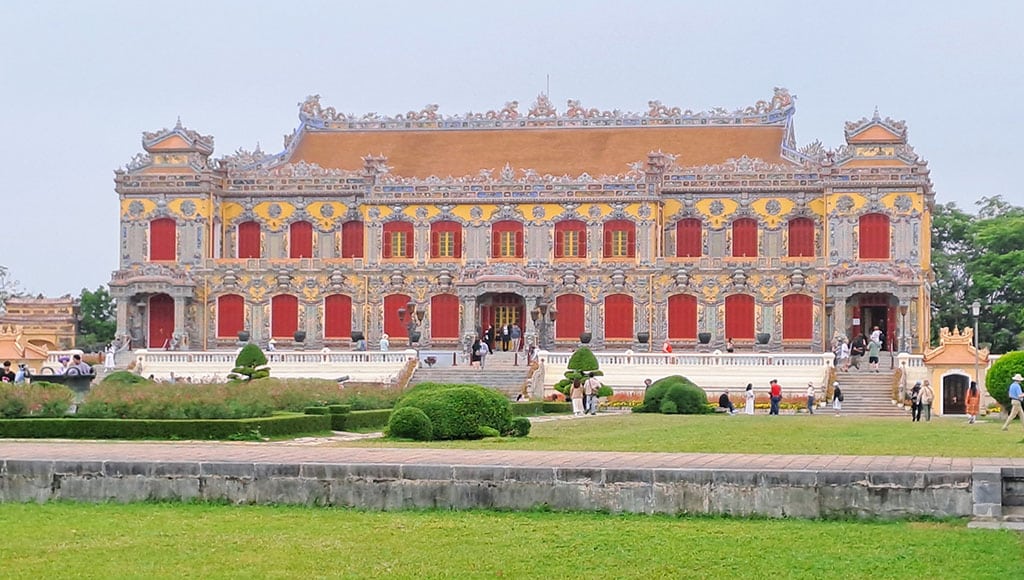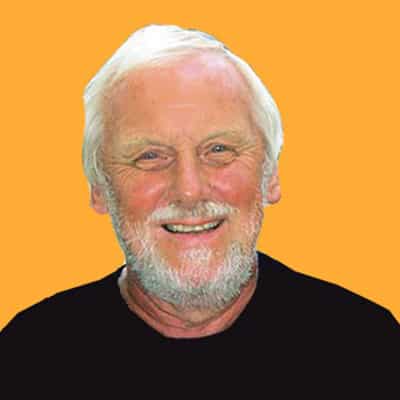A raucously loud horn sounded and made everyone jump! Immediately, people scattered in all directions away from the railway line. Any malingerers were hustled quickly by security men into the many cafés besides the track. The tourists got their cameras ready. And, whilst still drinking our morning coffee, we sat on the small seats that were provided perilously close to the rails. And then with a deep resonant blast on its own horn, the train appeared, rounded the corner and entered Hanoi’s world famous ‘Railway Street’.

A hundred cameras clicked and we all backed nervously away. This huge train passed less than half a metre from our noses. It is probably Hanoi’s most famous attraction, but this interesting city in the north of Vietnam has much more to offer than frighteningly big trains.
The first lesson for visitors to learn in any Vietnamese city is how to cross the road and survive! The country has 100 million people and 65 million scooters, most of which seem to be on the road at the same time. It really is ‘Scooter Land’. To cross the road, you take a deep breath, raise your hand and walk quickly straight across. Don’t deviate. Somehow the myriads of two wheelers will weave their way around your body and you arrive on the far side unscathed but with your blood pressure a tad higher!

Hanoi’s Old Quarter is fascinating and best investigated using a rickshaw. It has a labyrinth of narrow streets named after the various trades which once (and in some cases still do) practise there – from gold to leather to bamboo!
Here we enjoyed our first delicious ‘egg coffee’ with our lunch. This unusual coffee is made with egg yolks instead of milk!
An exploration of the city’s magnificent Temple of Literature gave us a chance to admire the best of traditional Vietnamese architecture. From as early as the 15th century, gifted students from all over the nation headed to Hanoi to study the principles of Confucianism, literature and poetry here. We loved this unique temple, with its picturesque gardens, bonsai, elegant buildings and colourful shrines. The whole place was made even more atmospheric by the presence of hundreds of students resplendent in their graduation robes – all seeking photo opportunities with proud parents.
Hanoi has a massive air pollution problem, so it was a relief to our lungs to drive south for two hours to enjoy the fresh air of the scenic countryside around Tam Coc, with its pointy limestone peaks and fertile green valleys. The ruins of Ninh Binh lie here. They are what remains of the ancient capital of Vietnam under the Dinh dynasty between 968 and 980 AD. It stretches over a wide area and has some nice Buddhist pagodas.
Tam Coc itself is a busy but attractive tourist town, famous as the launching place for peaceful river boating trips through stunning limestone scenery. We spent a relaxing couple of hours being rowed slowly in a small sampan along a pristine river, past paddy fields green with newly-planted rice and through caves in the mountains themselves.
The following day, on a separate boat trip, we visited some beautiful river caves with outstanding displays of stalactites and stalagmites.
We then cooked spring rolls for our own lunch in a quiet rural village, expertly supervised by the charming local ladies. Although constantly smiling, they were actually quite ruthless as to how we prepared the meat and vegetable ingredients. They then supervised our cooking with eagle eyes! But there was copious laughter and the resultant spring rolls were really quite tasty!

It was time to return to the coast and enjoy an overnight cruise at one of Vietnam’s most famous beauty spots, Ha Long Bay, a World Heritage Site. The weather was cloudy and misty but did not diminish the extraordinary beauty of the karst limestone mountains rising sheer out of the water. It is an amazing oceanic ecosystem. We didn’t actually do much cruising, the boat was stationary most of the time, which was a shame and certainly not what we all expected. However, the scenery was amazing, the cabins comfortable, the service on the boat impeccable and the food unbelievably tasty.
Ha Long Bay really is unique but now seriously overcrowded with tourist boats – a situation which is likely to get even worse as the Vietnamese seek to maximise their tourist dollar intake!

It was now time to leave the north of the country to discover something of Central Vietnam. We returned to Hanoi by car and flew south to Hué. The city is attractively set on the banks of the Perfume River (named after the tree resins and blossoms it carries to the Pacific Ocean). It was the capital of Vietnam between 1802 and 1945 under the Nguyen Emperors and later French colonial rule.
It has long been regarded as a centre of learning and our tour began with a river boat trip to the splendid Thien Mu Pagoda, which was busy with thousands of local ladies dressed up in their graceful Ao Dai national dress – a strikingly elegant symbol of beauty. It was here that I learned why the letters of the Vietnamese alphabet bear a striking resemblance to our own – abnormal in S.E. Asia. Portuguese missionaries, arriving in the 17th century, introduced Catholicism, and with it the Roman alphabet. It has been adopted locally ever since!

Nearby is the impressive Imperial Citadel and Forbidden Purple City. It is huge, modelled on the Forbidden City in Beijing, and was built by the Nguyen Emperors in the early 19th century. The imposing city walls are surrounded by a large moat. The whole area was badly damaged in the Vietnam war and much excellent renovation work is underway. Bullet holes can still be seen in many of the walls!
The main Palace building is intact but a bit like a wedding cake. It was not quite to our taste, but the emperors lived in grand style surrounded by their large harem of concubines. The local people love to dress up in the style of the emperor and his court, so there are colourful costumes on hire and during our visit could be seen everywhere.

Later in the day, we visited the Royal Mausoleum close to the south bank of the Perfume River. The Emperors built themselves lavish pavilions for their final resting places, and used them beforehand as recreational facilities for themselves and their concubines. They are imaginatively constructed and landscaped with lakes and trees. They were unquestionably built with pleasure in mind!
In Part 2, we continue our journey through Central Vietnam by visiting the ancient and charming trading centre of Hôi An, before flying south to explore a little of the Mekong Delta and Ho Chi Minh City.
By Nigel Wright
|| features@algarveresident.com
Nigel Wright and his wife Sue moved to Portugal 19 years ago. The couple lived and worked in the Far East and Middle East during the 1980s and 90s. Although now retired, Nigel still continues to travel and seek out new cultural experiences. His other interests include tennis, gardening and photography.




















